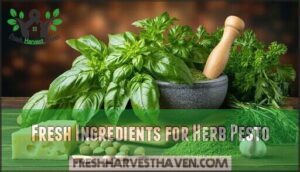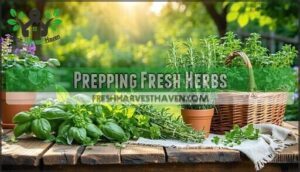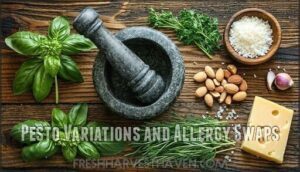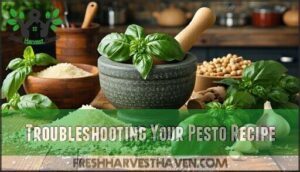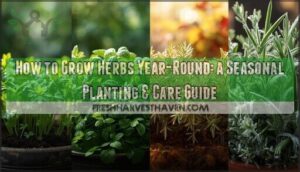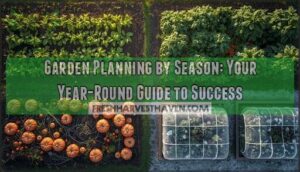This site is supported by our readers. We may earn a commission, at no cost to you, if you purchase through links.
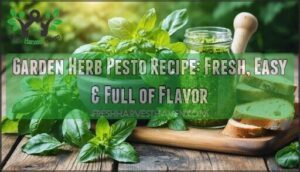
Making your own garden herb pesto takes maybe ten minutes, costs less than the fancy jarred stuff, and lets you experiment beyond traditional basil—mint, cilantro, parsley, or whatever’s thriving in your garden.
You’ll get a flexible sauce that works on pasta, pizza, sandwiches, or straight from the spoon when no one’s watching.
Table Of Contents
- Key Takeaways
- What is Garden Herb Pesto?
- Fresh Ingredients for Herb Pesto
- Step-by-Step: Making Garden Herb Pesto
- Pesto Variations and Allergy Swaps
- How to Store and Freeze Pesto
- Creative Ways to Use Pesto
- Troubleshooting Your Pesto Recipe
- Trending Pesto Topics and Market Insights
- Frequently Asked Questions (FAQs)
- Conclusion
Key Takeaways
- Fresh homemade pesto transforms everyday meals in under ten minutes and costs less than store-bought versions while giving you complete creative control over herbs, nuts, and flavor profiles beyond traditional basil.
- You can swap virtually any ingredient to accommodate allergies or preferences—sunflower seeds replace pine nuts, nutritional yeast stands in for Parmesan, and herbs like mint, cilantro, or parsley work just as well as basil.
- Proper storage techniques like pressing plastic wrap directly on the surface, adding a thin oil layer, or freezing in ice cube trays keep your pesto vibrant green and flavorful for weeks or even months.
- The key to exceptional pesto isn’t following recipes religiously but using whatever fresh herbs are thriving in your garden right now and trusting your own taste to guide ingredient ratios and combinations.
What is Garden Herb Pesto?
Garden herb pesto takes the classic Italian sauce and opens it up to whatever’s thriving in your garden or crisper drawer. While traditional pesto sticks to basil, pine nuts, and Parmesan, the garden version invites you to experiment with different herbs, nuts, and even skip the cheese entirely.
Here’s what makes it different, which herbs deliver the best flavor, and why this sauce does more than just taste good.
Classic Pesto Vs. Garden Herb Pesto
The truth is, classic pesto and garden herb pesto aren’t rivals—they’re more like cousins who share the same delicious DNA but bring their own personality to the table. Here’s what sets them apart:
- Pesto history traces classic versions strictly to basil leaves, garlic, Parmesan cheese, pine nuts, and olive oil
- Herb blends in garden pesto let you swap in mint, cilantro, or parsley
- Flavor profiles shift based on your choices—bolder with walnuts, brighter with lemon
- Pesto pairings expand when you experiment beyond tradition
Popular Herb Choices for Pesto
Once you’ve cracked open that world of herb swaps, you’ll want to know which ones actually shine in your bowl—and trust me, you’ve got more freedom here than you might think.
Basil varieties still lead the pack, but cilantro, mint, and parsley bring their own pesto flavors when you’re blending fresh herbs straight from your herb gardening haul.
Here’s your quick garden-to-table cheat sheet:
| Herb | Flavor Profile |
|---|---|
| Basil | Sweet, peppery classic |
| Mint | Bright, cooling kick |
| Cilantro | Bold, citrusy edge |
Mix leafy greens with spice combinations for custom pesto recipe magic.
Nutritional Benefits
Fresh herbs and quality oils deliver impressive nutrients in every spoonful while adding bold flavor to your meals. They provide heart-healthy fats that help balance your diet.
Basil and garlic offer antioxidant properties that combat cell damage.
A tablespoon delivers around 60 calories, 6g fat, and vitamins A and K—making this culinary nutrition powerhouse a smart dietary enhancement for your herb gardening payoff and healthy eating routine. Incorporating pesto into meals can provide numerous health benefits due to its high content of healthy fats sources.
Fresh Ingredients for Herb Pesto
Great pesto starts with ingredients that pack real flavor. The herbs, nuts, and cheese you choose shape everything from texture to taste.
Here’s what makes the biggest difference in your pesto.
Best Herbs to Use
Basil may be the star of the show, but your garden holds a whole lineup of herbs ready to steal the spotlight in your next batch of pesto.
Try blending basil varieties with these fresh herbs for bold pesto flavors:
- Parsley adds a mild, grassy backbone
- Mint brings cool brightness to leafy greens
- Cilantro delivers a zesty kick perfect for spice combinations
- Arugula lends a peppery edge to your herb pesto
Mix and match to create your signature garden pesto recipe.
Choosing The Right Nuts and Cheese
The nuts and cheese you choose don’t just bind your pesto together—they define its personality, turning a simple sauce into something nutty, sharp, creamy, or downright luxurious.
Pine nuts deliver traditional richness, but walnuts and almonds offer earthy depth at a fraction of the cost.
Parmesan cheese brings sharp, salty punch to your herb pesto preparation, while Pecorino Romano amps up the bold Italian food recipes vibe with extra bite.
Kitchen Tools: Food Processor Vs. Mortar and Pestle
The tool you pick—a food processor’s quick whir or the steady grinding of a mortar and pestle—affects more than just prep time.
It changes the pesto’s flavor and how it feels in your mouth.
A food processor delivers speed, blitzing garlic and pine nuts in seconds with the right blade maintenance and speed settings.
The mortar and pestle demands patience but rewards you with silkier texture and deeper flavor, as mortar techniques gently coax oils from herbs without bruising them into bitterness.
Step-by-Step: Making Garden Herb Pesto
Making garden herb pesto from scratch is easier than you think—and way more rewarding than cracking open a jar.
You’ll go from fresh leaves to silky, vibrant sauce in about ten minutes with just a few simple moves.
Here’s how to transform your herbs into something you’ll want to drizzle on everything.
Prepping Fresh Herbs
Start by washing your herbs thoroughly—grit and dirt don’t belong in anything this good—then pat them completely dry or give them a spin in a salad spinner. Strip basil and other tender leaves from their stems, since woody bits turn bitter when blended.
A fresh harvest from your herb garden means peak flavor, so manage those leaves gently to avoid bruising. This simple leaf preparation honors your garden-to-table approach and sets you up for vibrant, restaurant-quality pesto.
Blending With Oil and Pine Nuts
Toss those toasted pine nuts into your food processor along with a squeeze of lemon juice and a couple garlic cloves, then pulse until you’ve got a coarse, fragrant rubble that smells like you’ve already won dinner.
Add your prepped basil and pulse again—blender speed matters here, so use short bursts to keep things bright green instead of muddy.
Now drizzle in your olive oil while the blade runs, letting emulsion techniques work their magic until the flavor profiles marry into a silky, spoonable sauce with balanced oil ratios that cling to every noodle.
Adding Cheese (or Vegan Alternatives)
Grated Parmesan is the traditional crown on your pesto, but nutritional yeast, cashew cream, or even a good aged Pecorino can step in when you’re feeding dairy-free friends or just want to shake things up.
Add a handful of cheese options—try sharp manchego for boldness—and pulse until you’ve got herb-based sauces with flavor profiles that balance richness against green fire.
Whether you go classic Parmesan cheese or reach for vegan alternatives, you still deliver nutritional value.
Pesto Variations and Allergy Swaps
What makes pesto so versatile is how easily you can adjust it—swap out ingredients for allergies, match it to your diet, or just try something new.
You don’t have to stick with the traditional formula to get fantastic flavor. Let’s look at how you can swap ingredients and add your own spin without losing what makes pesto so good.
Nut-Free Pesto Options
If tree nut allergies are throwing a wrench in your pesto plans, sunflower seeds make a clever swap. This nut-free alternative keeps that creamy, rich texture without any pesto allergens.
You can also try breadcrumbs for body or fold in avocado for extra creaminess. These seed substitutions work beautifully in your garden pesto recipe, letting you create herb-based sauces and vegan pesto that everyone at the table can enjoy with fresh herbs.
Using a food processor with heart healthy fats can help achieve the perfect consistency for your pesto.
Dairy-Free and Vegan Swaps
Skipping cheese doesn’t mean you have to sacrifice that rich, savory punch—nutritional yeast brings a nutty, umami flavor that mimics Parmesan beautifully in plant-based pesto.
Here are five vegan cooking options to transform your pesto recipe:
- Nutritional yeast – Two tablespoons add cheesy depth
- Cashew cream – Blended cashews create silky texture
- Miso paste – Half a teaspoon boosts umami
- Vegan cheese – Store-bought options work in a pinch
- White beans – Pureed beans add body and protein
These nutritional swaps let you explore culinary creativity while keeping your herb garden pesto dairy-free.
Flavor Twists With Additional Herbs
Once you’ve nailed the vegan base, mixing in unexpected herbs can completely reinvent your pesto—think mint for bright sweetness, cilantro for a zesty kick, or parsley for a mellower, garden-fresh vibe.
Try bold herb combinations like basil-dill or oregano-thyme to craft aromatic blends that spotlight different flavor profiles.
Even spice infusions—a pinch of red pepper or smoked paprika—transform your garden pesto into something that feels entirely yours, perfect for summer herb pesto recipes straight from your garden-to-table kitchen.
How to Store and Freeze Pesto
You’ve put your heart into making fresh pesto, so don’t let it lose that vibrant flavor or bright green glow.
Storing it right keeps your hard work tasting garden-fresh for weeks or even months.
Here’s how to lock in that just-made magic, whether you’re reaching for it tomorrow or saving it for winter.
Refrigerator Storage Tips
You’ve put real work into blending that pesto, so naturally you want it to stay as bright and bold as it is right now.
Spoon it into airtight containers and press plastic wrap right against the surface—cutting off oxygen like this stops that dull brown color from creeping in.
Store it in the refrigerator for up to one week, checking for freshness each time you use it. Proper storage methods and food safety habits keep your garden-to-table creation vibrant and delicious.
Freezing for Longer Shelf Life
Want to keep that garden-fresh pesto around longer than a week? Pop it in the freezer and you’ll have up to a month of ready-to-use flavor waiting for you. Freezer storage is your best friend for long-term preservation—try these smart tricks:
- Pour pesto into ice cube trays for portion-controlled pesto ice cubes you can toss straight into pasta
- Press plastic wrap onto the surface before sealing containers to lock out freezer burn
- Label with the date so you know exactly when your garden pesto was made
- Thaw overnight in the fridge or stir frozen cubes directly into hot dishes for instant flavor
Frozen pesto quality stays strong when you store it right, giving you that garden-to-table taste even in the dead of winter.
Maintaining Fresh Flavor and Color
Nothing breaks the heart of a home cook faster than watching their vibrant green pesto turn murky brown.
Drizzle a thin layer of olive oil over the surface to lock in aromatic retention and block air exposure. Store your garden pesto in dark containers or wrap them in foil—light accelerates color loss.
For garden-to-table freshness, add a squeeze of lemon juice during blending to preserve that bright green hue and boost flavor naturally.
Creative Ways to Use Pesto
You’ve got a jar of fresh pesto sitting in your fridge—now what? The beauty of this green sauce is how easily it transforms everyday meals into something special.
Here are three ways to make the most of your homemade batch.
Tossing With Pasta
When that steaming bowl of pasta hits the table, tossing it with fresh pesto is where the real magic happens—it’s the fastest route from garden to fork, and you’re about to nail it in under two minutes.
Start with a 3:1 pasta-to-sauce ratio for classic Italian cuisine balance, then adjust to taste. The garlic and basil pesto coats every strand when you toss warm pasta with a splash of reserved cooking water—that starchy liquid creates silky flavor profiles perfect for meal prep or weeknight Italian food victories.
Spreading on Sandwiches or Pizza
Swap out your usual mayo or tomato sauce and slap a generous layer of pesto onto your next sandwich or pizza base—you’ll discover a whole new level of herby, garlicky boldness that makes every bite worth the mess.
Try pesto sandwiches with mozzarella and roasted red peppers, or spread your basil pesto edge-to-edge before adding pizza toppings like prosciutto and arugula.
These flavor combinations turn simple tasty fillings into unforgettable meals.
Stirring Into Soups and Bowls
A swirl of pesto stirred into minestrone or drizzled over a grain bowl transforms something ordinary into a meal that tastes like summer never left.
This herb sauce is your secret weapon for soups and stews that need a lift—just add a spoonful to lentil soup or chicken broth, and watch how those seasonal ingredients come alive.
For meal prep ideas, toss garden pesto into quinoa bowls or roasted vegetable medleys; it’s a cooking technique that turns leftovers into food recipes worth craving.
Troubleshooting Your Pesto Recipe
Even the best pesto can hit a snag—too bitter, too runny, or turning brown before you’ve even tossed it with pasta.
Don’t worry, these issues are easy to fix once you know what went wrong. Here’s how to rescue your pesto and get it back on track.
Fixing Bitter or Watery Pesto
Got pesto that bites back or runs like water? Don’t dump it—a couple of tweaks will fix it right up.
When bitterness hits (usually from garlic or basil that got worked too hard), balance it out with a small spoonful of sugar or honey.
For watery fix problems, blend in more nuts, cheese, or a drizzle of olive oil until you hit pesto balance. These flavor correction moves work with any herb-based sauces, giving your garden pesto the rich body it deserves.
Texture and Emulsification Tips
Getting your pesto to hold together like a dream—not separate into oily puddles or clump like wet sand—comes down to mastering the drizzle and knowing when to stop the blade. Add olive oil slowly while food processing to build emulsion stability, and pulse instead of blending nonstop—high blender speed heats the mix and breaks it apart.
For cooking with fresh herbs like garden pesto, ingredient order matters: nuts and garlic first, then greens, oil last. This keeps herb-based sauces smooth and your pesto sauce variations beautifully bound.
Preventing Browning
You’ve nailed the texture—now let’s keep that vibrant green from fading to a dull, swampy brown before you even get it to the table. Blanch basil for 10 seconds, then shock it in ice water to lock in that green color and slow oxidation control.
Pour a thin layer of olive oil over your garden pesto before fresh storage, or press plastic wrap directly onto the surface—both block air and prevent browning.
For food preservation wins, freeze flat in bags for herb preservation that stays bright all winter.
Trending Pesto Topics and Market Insights
Pesto’s everywhere right now, and if you’re making it at home, you’re part of something bigger.
Search interest jumps every summer, and more people want organic, plant-based versions—homemade herb sauces aren’t just trending, they’re evolving.
Let’s look at what’s driving demand, which trends are worth your attention, and the tools that’ll set you up for success.
Seasonality and Summer Demand
Every summer, basil takes over backyard gardens and pesto flies off grocery store shelves—because when the heat kicks in, we all crave that bright, herby escape.
Warm weather cooking runs on fresh markets and seasonal ingredients, and pesto sits right at the heart of that garden-to-table rhythm.
Search interest spikes in August, proving summer recipes thrive when herb and vegetable gardening peaks and seasonal flavors hit their stride.
Plant-Based and Organic Trends
Plant-based and organic pesto options are booming right now. The vegan pesto market hit $235 million in 2024, and clean-label products matter to 73% of shoppers.
You’ll spot cashews, kale, and nutritional yeast swapping in for traditional ingredients, while sustainable packaging and locally sourced basil answer the call for eco-friendly production.
This garden-to-table movement pairs perfectly with your herb and vegetable gardening, letting you craft seasonal cooking creations with vibrant flavor profiles and zero guilt.
Must-Have Tools for Pesto at Home
Getting pesto right at home is way simpler once you’ve lined up a few solid tools—and you really don’t need an arsenal.
A food processor with sharp blades tackles garden-fresh herbs in seconds, while a traditional mortar and pestle gives you that rustic, hand-ground texture herb sauces are known for.
Spice grinders and herb choppers also shine for small-batch culinary recipes that celebrate your gardening and cooking wins.
Frequently Asked Questions (FAQs)
Can I make pesto without a food processor?
Yes—grab your mortar and pestle for the most traditional approach. Hand-chopping herbs, then mixing with garden-fresh ingredients using manual methods, delivers authentic culinary creativity.
Blender alternatives work too, though pesto grinders require more elbow grease during seasonal harvest.
How long does homemade pesto stay fresh?
Your homemade garden herb pesto stays fresh in the fridge for up to one week when stored properly in an airtight container.
Freezing extends pesto shelf life to about one month, making refrigeration safety and proper storage methods essential for maintaining that garden-fresh flavor.
What causes pesto to turn brown overnight?
Oxidation effects from air exposure cause fresh garden herb pesto to brown overnight. Enzyme activity in basil leaves breaks down chlorophyll, especially when garlic and pine nuts are blended—similar to how apples darken after slicing.
Proper storage conditions slow this natural process.
Can I substitute spinach for fresh basil?
Thinking about swapping spinach for basil? You absolutely can—it’ll create a milder, earthier pesto.
Spinach works beautifully when you’re short on basil or want nutrient-rich greens in your garden-fresh herb pesto, though you’ll lose that signature peppery punch.
Should I toast pine nuts before adding them?
Toasting pine nuts before blending unlocks richer, deeper flavor—just heat them in a dry skillet until golden and fragrant.
This simple pine nut prep step elevates your garden fresh herb pesto with enhanced nutty texture.
Conclusion
The best pesto doesn’t come from a recipe you follow religiously—it comes from whatever herbs are begging to be picked from your garden right now.
Once you’ve nailed your delicious garden herb pesto recipe, you’ll realize the freedom that comes from ignoring rules and trusting your taste buds instead.
Grab your blender, raid your herb bed, and start building flavors that reflect your garden, not someone else’s. Your pasta has never tasted this honest.
- https://hungryhealthyhappy.com/mixed-herb-pesto/
- https://ucanr.edu/blog/food-blog/article/south-coast-rec-studies-pesto-profitability-small-scale-basil-growers
- https://www.accio.com/business/store_bought_pesto_trend
- https://lovelegrand.com/en/produit/garden-pesto/
- https://www.deliciousacademy.nl/cursussen/delicious-basiscursus-pasta/

